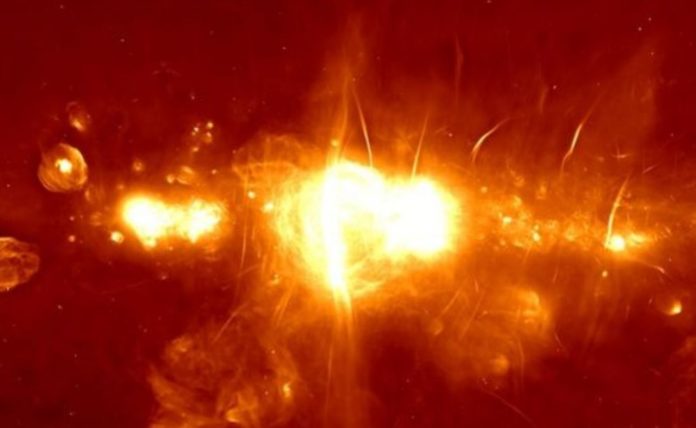An ‘invisible barrier’ that allows cosmic rays created by our own galaxy to escape, but it prevents those from the outside from entering.
The Milky Way galaxy, our home in space, never ceases to amaze astronomers, and a new finding revealed that the galaxy’s core is far stranger than previously believed.
A team of researchers from the Chinese Academy of Sciences in Nanjing has published a gamma ray map of the galactic center in the journal ‘Nature Communications’.
Gamma rays are the most energetic kind of light in the Universe, formed when extremely fast particles known as cosmic rays clash with matter.
The map validates the previously held belief that the black hole at the center of the Milky Way is accelerating particles at massive speeds, very close to the speed of light, resulting in a large amount of gamma rays around the Milky Way’s border.
Despite the fact that this implies a constant storm of high-energy radiation being launched into space, the researchers noted that ‘something’ around the galactic nucleus is preventing cosmic rays from entering from other areas of the Universe.
The study’s authors refer to this ‘something’ as an ‘invisible barrier’ that completely envelops the galactic center and prevents the majority of cosmic rays from the outside from entering. In other words, cosmic rays can depart but not enter the galaxy’s center. How or why this cosmic barrier exists is a complete mystery.
Dense and dusty
The Milky Way’s core is approximately 26,000 light years from Earth, in the constellation Sagittarius. It is a thick and dusty environment in which the stars are squeezed together. There are, in effect, a million times more stars per light year in this region than in any other in the galaxy. And it’s all centered on a big supermassive black hole called Sagittarius A *, which has a mass four million times that of the Sun.
Scientists have long hypothesized that the black hole accelerates protons and electrons to near-light speeds, resulting in cosmic rays that our galaxy radiates in all directions into intergalactic space. These rays propagate through the galaxy’s magnetic fields, forming a genuine ‘ocean of particles’ with a nearly uniform density across the Milky Way. A veritable ‘particle soup’ that perpetually bathes the entire galaxy and is dubbed a ‘sea of cosmic rays’ by astronomers.
The researchers compared the density of cosmic rays in that sea to that of cosmic rays in the galactic center in their study. This is how scientists established that the black hole at the galactic center is truly serving as a massive particle accelerator, ‘shooting’ cosmic rays out towards the galaxy’s outer regions.
However, the map revealed the mysterious ‘barrier,’ which had been completely unknown until recently. It is an easily discernible line immediately outside the galactic center, beyond which the density of cosmic rays rapidly decreases. The source of this phenomenon is more difficult to pinpoint, but it could have something to do with the jumble of magnetic fields at our galaxy’s dense core.
The authors of the study speculate that massive clouds of dust and gas near the galactic center may collapse in on themselves, compressing magnetic fields and forming a cosmic-ray-proof barrier. Alternatively, just as the solar wind does, the stellar winds from the many stars that inhabit the center may be pushing against the sea of cosmic rays.
Whatever the case, the primary conclusion is that additional research is necessary to ascertain precisely what is occurring in the mysterious depths of the Milky Way.
Source: 10.1038/s41467-021-26436-z
You were reading: Something is preventing the universe’s fastest particles from entering the galaxy’s center
